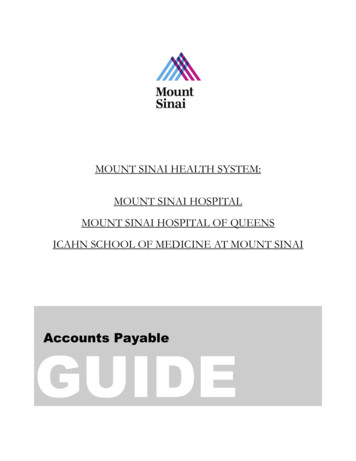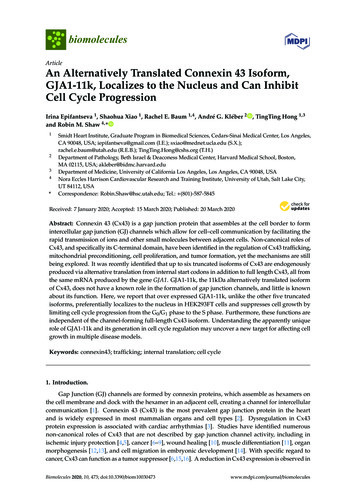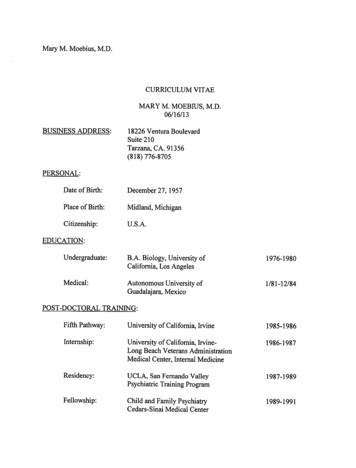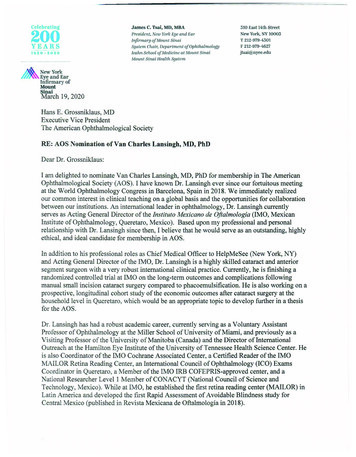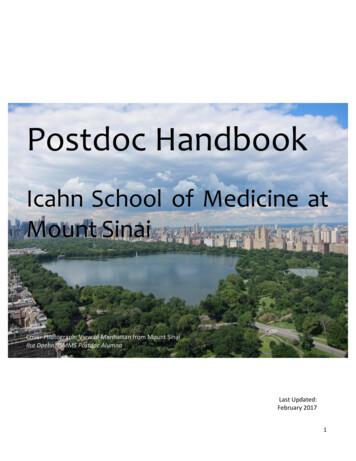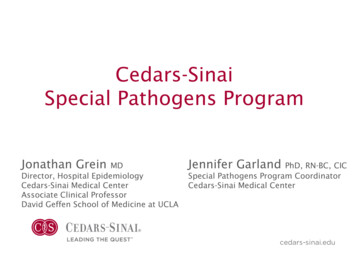
Transcription
Cedars-SinaiSpecial Pathogens ProgramJonathan GreinMDDirector, Hospital EpidemiologyCedars-Sinai Medical CenterAssociate Clinical ProfessorDavid Geffen School of Medicine at UCLAJennifer GarlandPhD, RN-BC, CICSpecial Pathogens Program CoordinatorCedars-Sinai Medical Center
Cedars-Sinai 886-bed tertiary care, academic, communitynot-for-profit medical center in Los Angeles 50,000 admissions per year 14,000 full-time employees 500 residents and fellows in graduate medicalprograms Magnet Excellence in Nursing designation fourconsecutive times CS designated as the Region IX Ebola TreatmentCenter in June 2016 (through mid-2020)2
27 patients cared for in the US/Europe:–Hospital stay 20 days (median)–85% received investigation therapy–Mortality 18.5% Take Away for Ebola Treatment Centers:–Long hospitalization–Be prepared to use investigational agents–High quality care can improve outcomes3Uyeki TM et al, NEJM 2016; 374: 636-46
Regional Special Pathogens Center:Key Responsibilities Be prepared to receive a patientwithin 8 hours of notification Capacity to care for 2 simultaneouspatients (including 1 child) Maintain a trained response team Maintain adequate supplies ofpersonal protective equipment(PPE) Capacity to handle a high volumeof infectious waste Annual NETEC onsite assessment4
Cedars-Sinai Special Pathogens Program Special Pathogens Program Coordinator Special Pathogen Response Team (SPRT)Multi-disciplinary Task Force SPRT Clinical Response Team (voluntary)–Nurses–Physicians–Respiratory therapy–Laboratory–Environmental Services–Imaging Quarterly Training and Exercises5
Treatment Areas Ambulance bay to accept EMS ground transport Secured, private bay Separate from ED ambulance bay Direct and controlled access to medical ICU Emergency Department Dedicated ED room adjacent to traumaelevator Direct and controlled access to medical ICU Commode accessible Medical ICU Two (2) adjacent negative-pressureisolation rooms Large shared anteroom Secured access6
Emergency Department Preparation7Identify Isolate Inform
Emergency Department Preparation Incorporated Special Pathogenseducation into annual ED training No-notice walk-in drills– Assess time to isolation andnotification– Also “no-notice” training PPE supplies stored in ED Rapid Activation Protocol– Goal: Maximize safety whiledetermining if patient may be a PUI– Get trained “safety monitor”/IP onsite ASAP– PPE at door/ensure appropriate use– Minimize traffic/patient contact– Maintain access log– Initiate Special Pathogen teamactivation if determined to meet PUIcriteria Focus preparation on the most likelyscenarios, not the most extreme Learn from real world events8
Special Pathogen Team/Unit Activation Immediate local health department notification Special Pathogen clinical response team activation (Everbridge notification) Hospital Incident Command Center activation–Internal/External communication (templates prepared) Treatment Unit Set-up (unit activation checklist) Just-In-Time training for response team Experimental Therapy (Zmapp) protocol activation (requires patient weight)9
Special Pathogen Response Team Membership is voluntary.– Must be able to tolerate PPE for 4 consecutivehours and commit to quarterly training Initial training includes:– Activation Protocols– Infection Control practices– Member roles and responsibilities– Personal Protective Equipment– Behavioral health Refresher training (quarterly)– PPE donning/doffing– Skills while in PPE (i.e., PIV placement,intubation) “Just-in-Time” training Dedicated training for Safety Monitors, Security Physician consultants (e.g., nephrologists) toutilize telemedicine equipment for patient care10
Portable Laboratory (Neighboring Patient Room) Portable Class 2 Biosafety cabinetsetup in adjacent room Lab techs will work in pairs (bothin full PPE) Specimen handoff protocols Category A Specimen packaging No labs performed in mainlaboratory Testing capabilities include:–Electrolytes, CBC withdifferential, LFT, coagulationstudies, urinalysis, malaria, rapidinfluenza, HIV, pregnancy test11
Waste Management Waste Streams–EMS/Ambulance waste–ED–Treatment area (ICU) Liquid waste–Pretreatment with disinfectant–Applies to toilet, sink, dialysate Solid waste–Dedicated transport pathway–Four large-capacity onsite autoclaves–Contracted third-party waste transportvendor (backup)12
Special Pathogens Exercises Conducted quarterly Often involve multiple external agencies (e.g.,health department, EMS) Always include a previously untested skill April 2018: “Tranquil Terminus”–Largest patient movement exercise in DHHShistory–Cedars-Sinai accepted 2 patients flown to LAXfrom Idaho (via Washington)–Command Center activation; teamnotification and staffing plan–Experimental therapy (Zmapp); drug receivedwithin 24 hours and appropriately dosed13
Other Recent Exercises Admission of a patient with viral hemorrhagic fever (VHF)–Lab draw and reporting, remote clinical consultation, dialysis initiation,intubation Inpatient with confirmed VHF–Portable CXR, spill management, waste transport Management of two VHF patients simultaneously–Informed Consent for experimental therapy Management of a cluster of patients with Middle East Respiratory Syndrome(MERS)14
Summary; Cedars-Sinai Special Pathogens Program As the regional Ebola/Special Pathogen Treatment Center, Cedars-Sinai remainsprepared to manage up to two patients with “special pathogens” within 8 hoursof notification Cedars-Sinai conducts quarterly training and exercises to continue to expand ourtreatment capabilities Considerations for hospitals preparing to manage a patients suspected of havingEbola:–Emphasize readiness for the likely presentation of a PUI–Unannounced “walk-in” exercises can be an effective tool to reinforce theconcept of “Identify, Isolate, Inform” with front line staff–Consider “rapid activation” checklists to promote healthcare worker andpatient safety while assessing a patient as a possible PUI–Close collaboration with your local health department is essential15
Thank you16
Cedars-Sinai 886-d tertiary care, academic, community be not-for-profit medical center in Los Angeles 50,000 admissions per year 14,000 full-time employees 500 residents and fellows in graduate medical programs Magnet Excellence in Nursing designation four consecutive times CS designated as the Region IX Ebola Treatment

